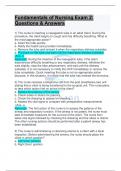Exam (elaborations)
Exam 2:Fundamentals of Nursing Exam 2: Questions & Answers; Guaranteed A+ Guide
- Course
- Fundamentals Of Nursing
- Institution
- Keiser University
The nurse is inserting a nasogastric tube in an adult client. During the procedure, the client begins to cough and has difficulty breathing. What is the most appropriate action? a. Insert the tube quickly. b. Notify the health care provider immediately. c. Remove the tube and reinsert it when th...
[Show more]



